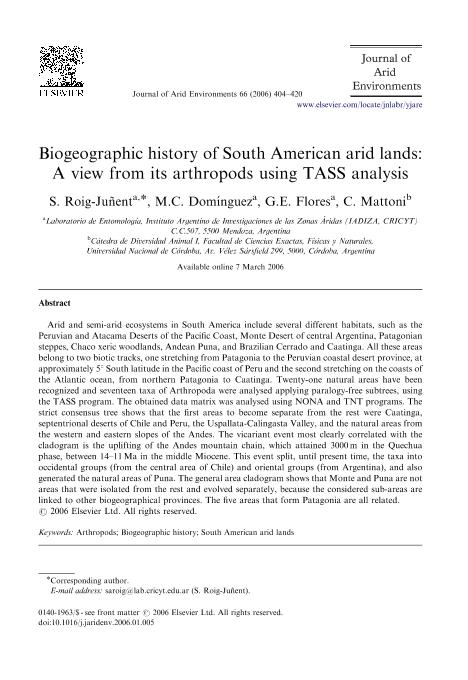Artículo
Biogeographic history of South American arid lands: A view from its arthropods using TASS analysis
Fecha de publicación:
12/2006
Editorial:
Academic Press Ltd - Elsevier Science Ltd
Revista:
Journal of Arid Environments
ISSN:
0140-1963
Idioma:
Inglés
Tipo de recurso:
Artículo publicado
Clasificación temática:
Resumen
Arid and semi-arid ecosystems in South America include several different habitats, such as the Peruvian and Atacama Deserts of the Pacific Coast, Monte Desert of central Argentina, Patagonian steppes, Chaco xeric woodlands, Andean Puna, and Brazilian Cerrado and Caatinga. All these areas belong to two biotic tracks, one stretching from Patagonia to the Peruvian coastal desert province, at approximately 5° South latitude in the Pacific coast of Peru and the second stretching on the coasts of the Atlantic ocean, from northern Patagonia to Caatinga. Twenty-one natural areas have been recognized and seventeen taxa of Arthropoda were analysed applying paralogy-free subtrees, using the TASS program. The obtained data matrix was analysed using NONA and TNT programs. The strict consensus tree shows that the first areas to become separate from the rest were Caatinga, septentrional deserts of Chile and Peru, the Uspallata-Calingasta Valley, and the natural areas from the western and eastern slopes of the Andes. The vicariant event most clearly correlated with the cladogram is the uplifting of the Andes mountain chain, which attained 3000 m in the Quechua phase, between 14-11 Ma in the middle Miocene. This event split, until present time, the taxa into occidental groups (from the central area of Chile) and oriental groups (from Argentina), and also generated the natural areas of Puna. The general area cladogram shows that Monte and Puna are not areas that were isolated from the rest and evolved separately, because the considered sub-areas are linked to other biogeographical provinces. The five areas that form Patagonia are all related.
Palabras clave:
ARTHROPODS
,
BIOGEOGRAPHIC HISTORY
,
SOUTH AMERICAN ARID LANDS
Archivos asociados
Licencia
Identificadores
Colecciones
Articulos(IADIZA)
Articulos de INST. ARG DE INVEST. DE LAS ZONAS ARIDAS
Articulos de INST. ARG DE INVEST. DE LAS ZONAS ARIDAS
Citación
Roig, Sergio Alberto; Dominguez, Martha Cecilia; Flores, Gustavo Ernesto; Mattoni, Camilo Ivan; Biogeographic history of South American arid lands: A view from its arthropods using TASS analysis; Academic Press Ltd - Elsevier Science Ltd; Journal of Arid Environments; 66; 3; 12-2006; 404-420
Compartir
Altmétricas




